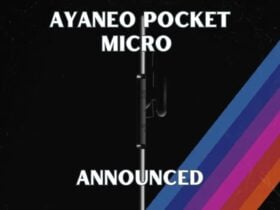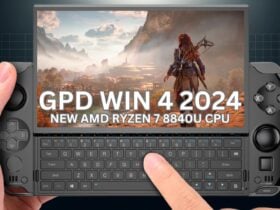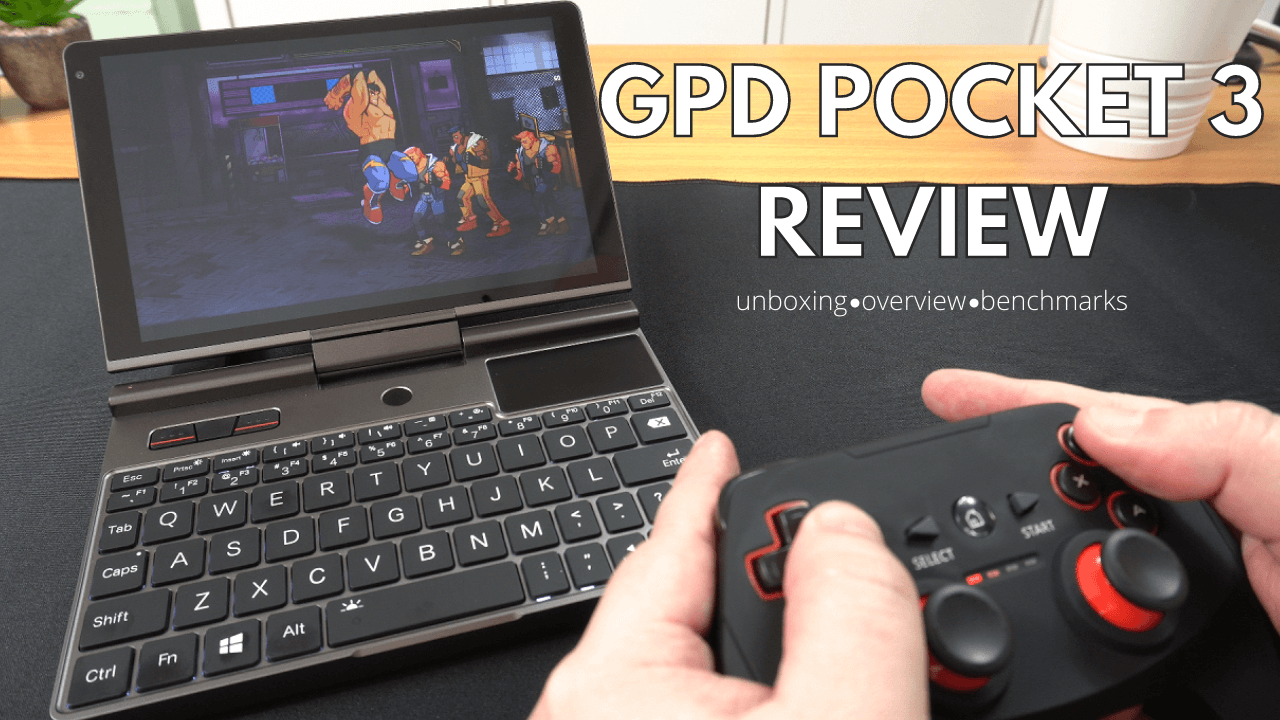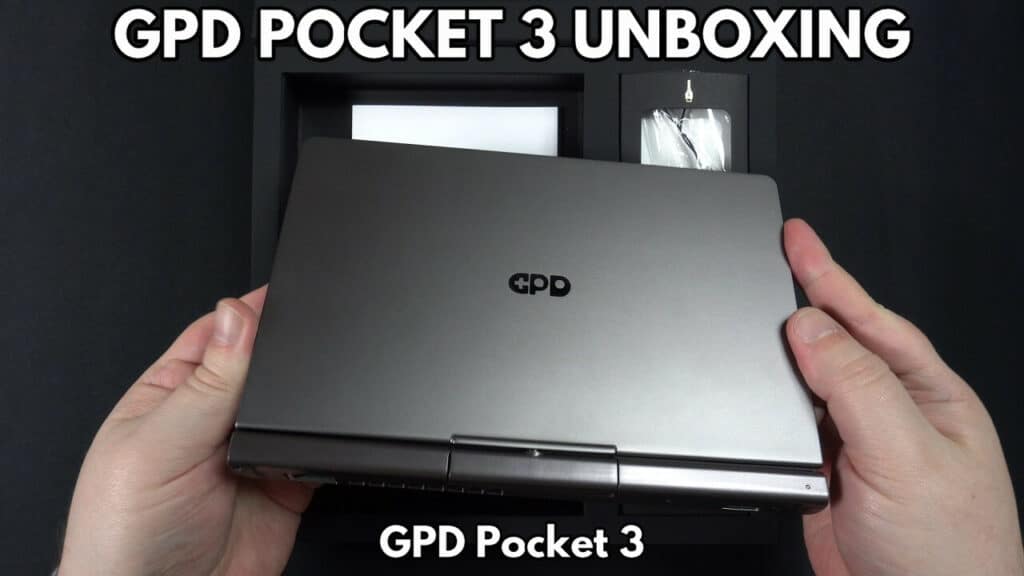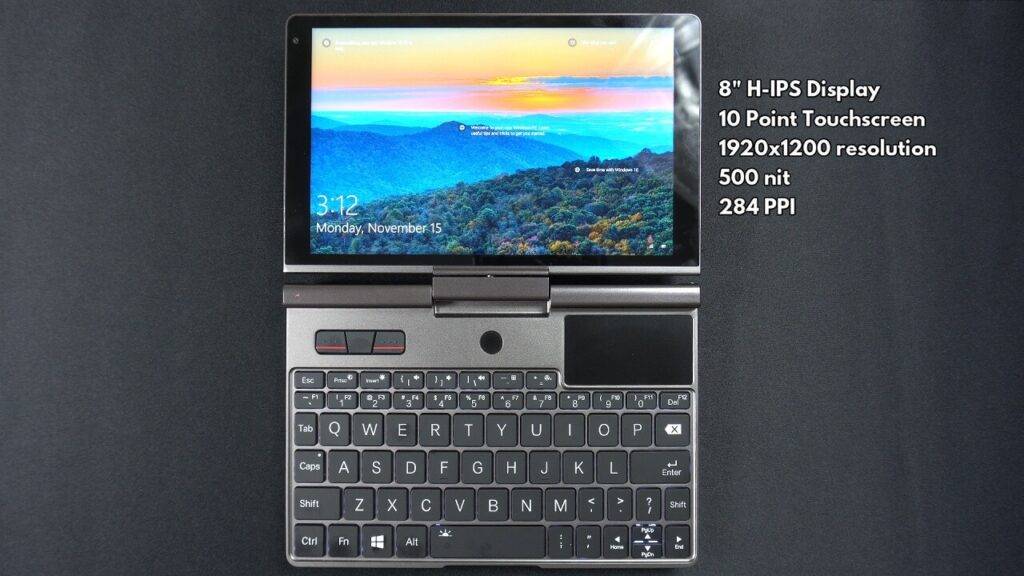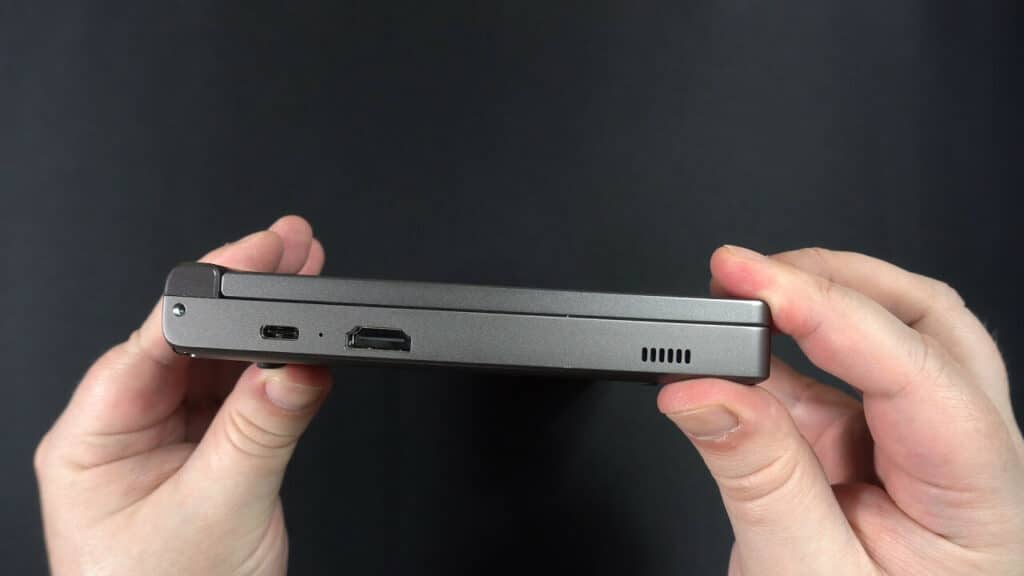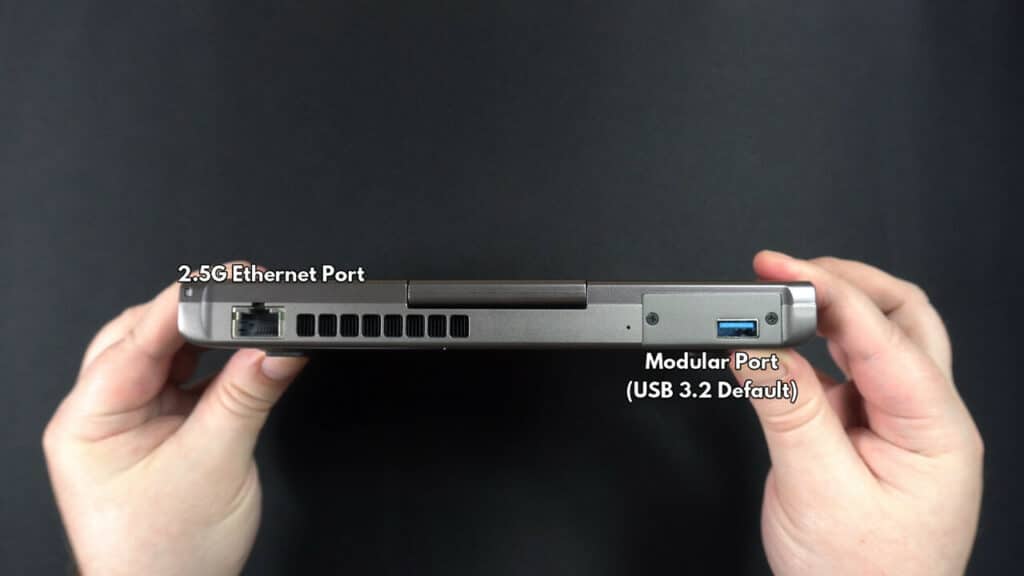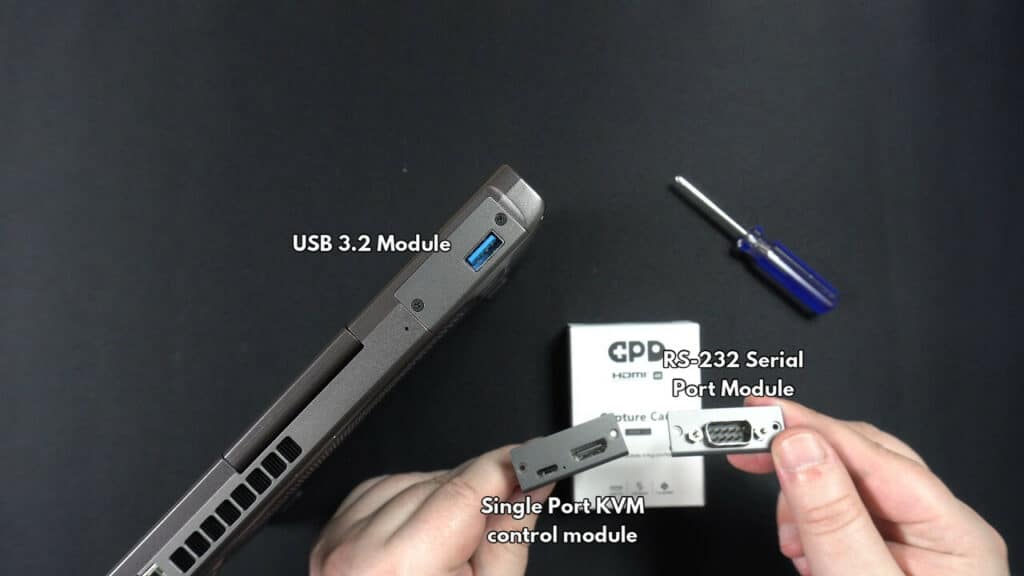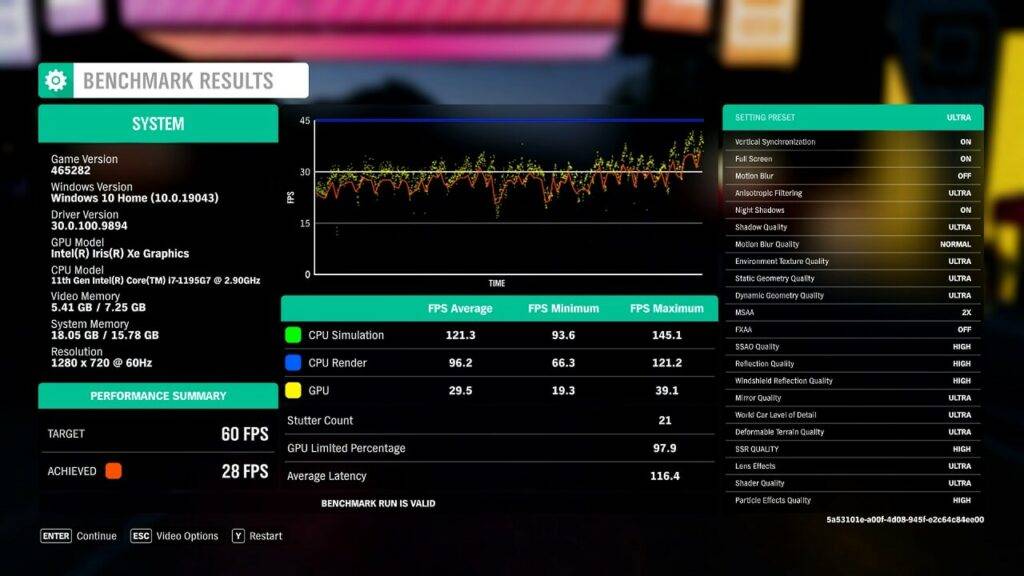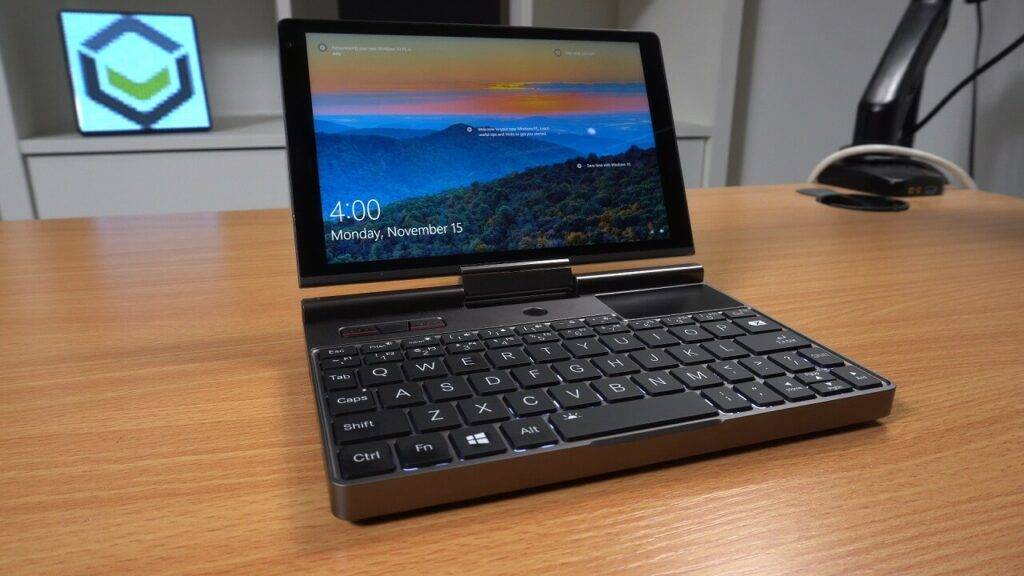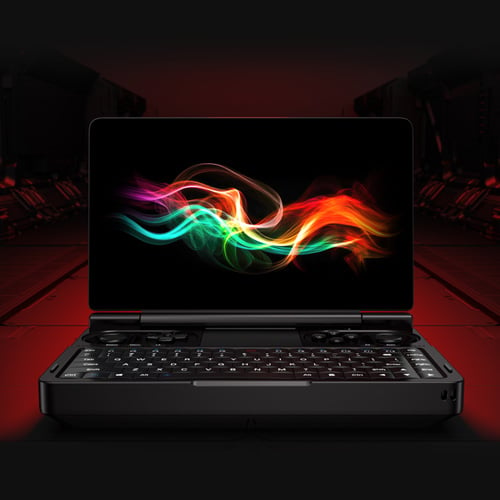GPD Pocket 3 Review
-
Performance
(4.8)
-
Build quality
(5)
-
Features
(4.5)
-
Portability
(5)
Summary
A high performance mini laptop that transforms into a tablet! Great battery life under normal usage and modular ports for industry work with RS-232 communications.
Overall
4.8User Review
( votes)Pros
- Fast Intel i7 1195G7 processor
- Extremely portable and lightweight
- Up to 8 hours battery life
- Modular ports for expandability
- Rotating display to turn into a tablet
- Great for some gaming as well
Cons
- Quite expensive
Today in our review we are taking a look at the GPD Pocket 3 mini laptop. We will be unboxing it, taking a closer look at the features including its modular design, then running some system and gaming benchmark tests to see how it performs.
GPD Pocket 3 Review Video
Unboxing the GPD Pocket 3
We have the GPD Pocket 3 which we will show in more detail shortly.
Underneath is a quick start user guide in Chinese and English. Under the packaging is a hand strap for the Pocket 3. There is a USB Type-C cable for charging. And last but not least is a charger. We will include the correct adaptor for your country when you order from us at DroiX.
GPD Pocket 3 Overview
The GPD Pocket 3 measures 7.8 x 5 x 0.78 inches (19.8 x 12.7 x 2 cm) when closed and weighs 725 grams.
The Pocket 3 lifts open to reveal the 8 inch H-IPS 1920×1200 resolution screen, which supports 10 point touch control. There is a 2 mega pixel 1600×1200 camera on the top left area which is great for video calls.
On the base of the Pocket 3 are the left, middle and right mouse buttons. In the middle is a fingerprint scanner which also acts as the power button. And on the right is the mouse pad. Below is a QWERTY keyboard that is backlit and can be toggled with a keypress combination.
The display can be rotated clockwise and folded to turn the laptop into a tablet style device. It can be used in conjunction with the Stylus, available to purchase separately.
One thing of note is that there is no sensor to check when the screen is rotated. The screen does not orientate automatically and you would need to do this manually. Update: The model now has a gyro-sensor which will automatically orientate the display to the correct position.
On the right side is a 3.5mm headphone jack and two USB 3.2 ports.
On the left side is a USB Type-C port and HDMI output for connecting to a TV or monitor. The Type-C port is Thunderbolt 4 compatible and can be with a variety of peripherals such as a hub or even an external graphics card.
On the back is a 2.5 gigabit ethernet port. Followed by the modular port which we will show in more detail next.
GPD Pocket 3 Modular Port
The GPD Pocket 3 features a modular port which allows you to swap the module to provide other Input/Output options. With the Pocket 3 you get the USB 3.2 module installed as default.
There are other options available to purchase separately such as a RS-232 serial port for industry data communication. And a single port KVM control module that has HDMI and USB support.
Exchanging the modules is very easy. Simply unscrew the two screws. Remove the module and insert the replacement module. Then screw it back in and you are ready to go!
GPD Pocket 3 Technical Specifications
| GPD POCKET 3 BASE | GPD POCKET 3 HIGH END | |
| CPU | Intel Pentium Silver N6000 4 core 4 threads | Intel Core i7-1195G7 4 cores 8 threads |
| BASE / MAX FREQUENCY | 1.10Ghz / 2.50Ghz | 2.90Ghz /4.60Ghz |
| GPU | Intel UHD Graphics @ 850Mhz | Intel Iris Xe Graphics @ 1.40Ghz |
| RAM | 8GB LPDDR4x @ 2933Mhz | 16GB LPDDR4x @ 3733Mhz |
| STORAGE | 512GB NVMe 1.3 PCIe Gen 3.0 x4 | 1TB NVMe 1.3 / 1.4 PCIe Gen 3.0 / 4.0 x4 |
| CONNECTIVITY | 2.5Gbps via RJ45 IEEE 802.11 a/b/g/n/ac/ax – Dual Band Wi-Fi 6 Bluetooth 5.0 | 2.5Gbps via RJ45 IEEE 802.11 a/b/g/n/ac/ax – Dual Band Wi-Fi 6 Bluetooth 5.0 |
| BATTERY | 38.5Wh 7.7V==5000mAhx 2 Series Li-Polymer battery | 8.5Wh 7.7V==5000mAhx 2 Series Li-Polymer battery |
System Benchmarks
Although the Pocket 3 uses the same i7 1195G7 processor as the GPD Win 3 and GPD Win MAX 2021 gaming handhelds. It is by default at a lower TDP of 15W instead of 20W like the others. TDP is the amount of power provided to the device. The more power that is provided the higher performance it will run at, but at the cost of using more battery power. Running with a lower TDP will reduce performance and use less power.
Having the TDP set to 15W will help conserve battery power. Very high performance may not be required for tasks like web browsing or working with office documents. You can of course increase the TDP to 20W to match the gaming handhelds for more performance, but at the cost of using more battery power.
PassMark
We start our benchmark with PassMark which pushes the CPU, GPU, RAM and storage to their maximum in a series of artificial tests for maximum performance.
The Pocket has a score of 2,989 which is a very good score for a mini laptop.
PCMark
Our next test is PCMark which is more of your day to day usage series of performance tests ranging from web browsing, video conferencing, media consumption and large office documents.
The GPD Pocket 3 scores 4,695. The scores here are very good as it means that boot times are fast and loading software is faster than average. This extends to working with large office documents which are faster to open, work with and then save.
3DMark
Our last system benchmark is for 3DMark which tests the CPU and GPU together for their performance for tasks such as video decoding, image processing and of course gaming.
The Pocket 3 scores a decent 1,038. If you work with images or video you will see great performance from this mini laptop!
GPD Pocket 3 Review: Gaming Benchmarks
We are running these tests at 15W TDP so the scores will be lower than the GPD gaming handhelds, but as mentioned this can be increased to 20W to have similar performance.
Forza Horizon 4
We start the gaming test with Forza Horizon 4 running at 1280×720 on Ultra settings. The GPD Pocket 3 scores 28 frames per second.
Street FIghter V
Next we are testing Street Fighter V running at 1920×1080 with Maximum settings. The Pocket 3 reaches a decent 33.4 frames per second.
Final Fantasy XIV
Next we are running the Final Fantasy benchmark at 1920×1080 on the High Desktop settings. The modular laptop scores 2,992. With a few minor graphics settings you can get the ranking to a standard level.

Shadow Of the Tomb Raider
Our final test is for the shadow of the tomb raider. We are using the 1280×720 resolution running the test with the lowest and highest graphics settings to compare.
The Pocket 3 scores 32 frames per second on Lowest graphics settings and 20 on the highest. They are decent scores.
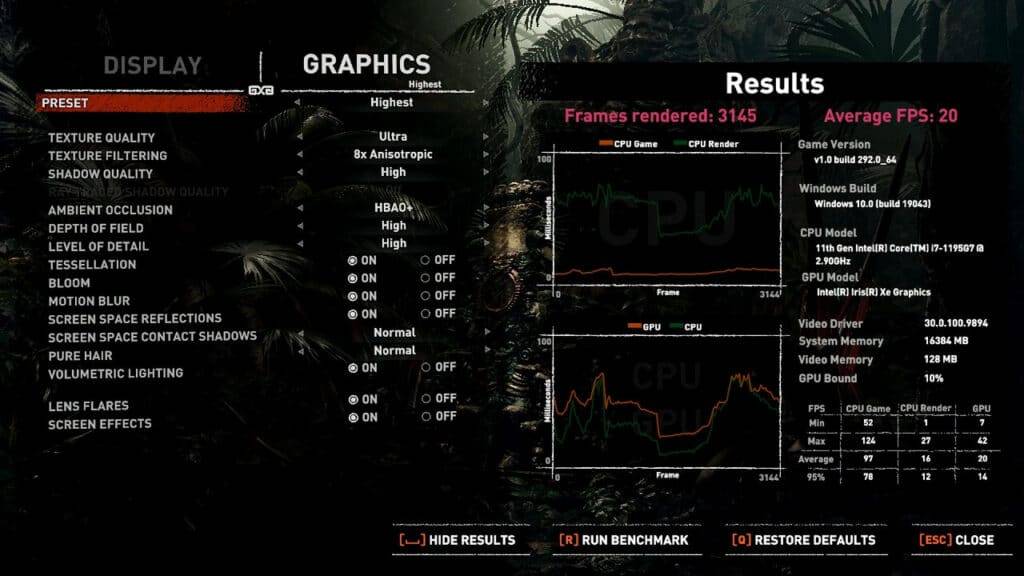
GPD Pocket 3 Review: Benchmark Summary
A quick recap of the benchmark scores as well as the battery test under full load that we have performed for the GPD Pocket 3 Review
| GPD POCKET 3 HIGH END | |
| PASSMARK | 2,989 |
| PCMARK | 4,695 |
| 3DMARK | 1,038 |
| FORZA HORIZON 4 | 28 FPS |
| STREET FIGHTER V | 33.4 FPS |
| FINAL FANTASY XIV | 2,992 |
| SHADOW OF THE TOMB RAIDER | Lowest Default Settings: 32 FPS Highest Default Settings: 20 FPS |
| BATTERY TEST | Idle Load: 8 hours Full Load: 1 hour 58 mins |
Keeping in mind that these tests were performed on the default 15W TDP, the scores are very good for both the system and gaming benchmarks. Using the product as intended for your day to day tasks it will perform them very well and also conserve battery life.
For some gaming on the side, you can head straight into the action or if you want some extra performance you can increase the TDP to 20W to get more in the performance area of the GPD gaming handhelds.
Our battery life test results are around what GPD provided. Under full load, the battery lasted 1 hour 58 minutes. Setting idle on the desktop saw around 7 to 8 hours battery life.
GPD Pocket 3 Review: Summary
To round off our GPD Pocket 3 review, we think the GPD Pocket 3 is very impressive! We like that the display can be rotated to turn into a tablet style device. Although not automatically orientating the screen is a bit of a let down. The CPU is very high performing, and if you need an extra boost of power for gaming then you can easily increase the TDP.
We like the modular design where you can replace the modules as and when needed. The RS232 port for example is great for IT Technicians, as is the KVM module. We hope to see some more modules released in the future!
For the average day to day tasks for home and work, through to higher end applications, and not forgetting a bit of gaming on the side, you won’t find a better mini laptop than the GPD Pocket 3!
Where to buy the GPD Pocket 3
You can learn more and buy the GPD Pocket 3 here. Browse the range of GPD products, or mini laptops here.
GPD Pocket 3 FAQ – Everything We Know So Far
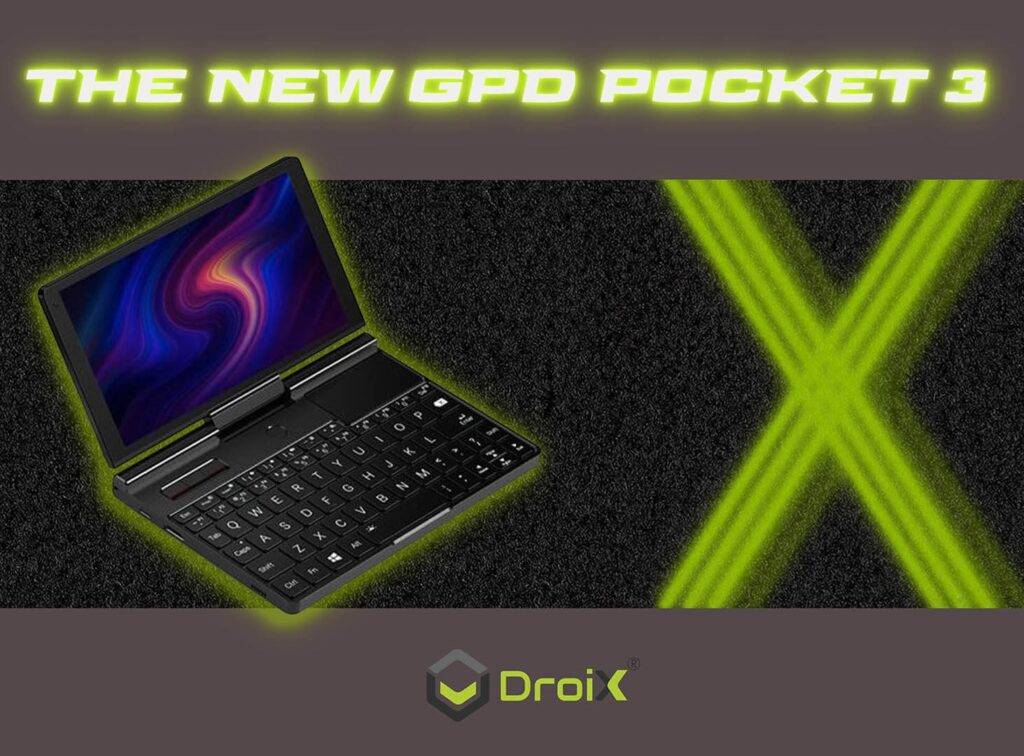
Originally posted by benjamin on: 24/09/2021
Welcome to the DroiX GPD Pocket 3 FAQ – where we gather all the information we’re able to about GPD‘s latest up-and-coming laptop, the GPD Pocket 3.
With the year coming to a close many companies announce new hardware that is set to enter the market, and GPD are no exception announcing two new high-end devices within a short time period (the first being the GPD XP).
[30/12/2021 Update] Our Own Review, Pre Order Dates, and more!
[30/12/2021 Update] Dusting off the Cobwebs
It’s been some time since we updated this FAQ! So let’s not waste time on idle paragraphs and get right into the meat of things.
First of all, if you haven’t seen it already. The official DroiX review of the GPD Pocket 3 is now online and available to the public. You can either check out our GPD Pocket 3 Review blogpost, or watch the video below to learn more about this awesome mini laptop.
Second, the GPD Pocket 3 is available to order directly from droix.co.uk and droix.net. This includes both the high-end and low-end versions.
The current ETA for the GPD Pocket 3’s to arrive with us at DroIX is now early January. Once they arrive, pre orders will be fulfilled first, and should any devices be left, they’ll be available for regular purchasing.
We’ll update this post once the GPD Pocket 3’s are available. So stay tuned until then!
[12/10/2021 Update] IndieGogo, specifics, and more
It’s been a while since our last update! Let’s get right into what’s new with the GPD Pocket 3.
GPD Pocket 3 IndieGogo/Crowdfunding Details
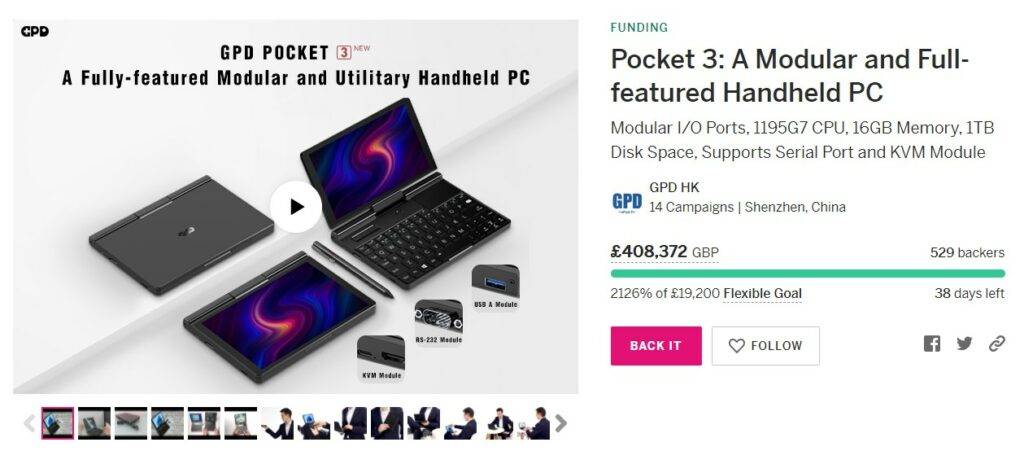
First of all, the GPD Pocket 3 crowdfunding campaign has been launched. Both versions, Pentium and i7, can be purchased bundled with a stylus, or bundled with both the Stylus and the KVM/RS-232 modules for a little extra.
The prices for the GPD Pocket 3 (when ordered from GPD’s IndieGogo) are currently as follows:
- $5,056 HKD (approx. £485 GBP) for the base (Pentium) model.
- $7,770 HKD (approx. £746 GBP) for the high-end (i7 model).
Both of these come bundled with a stylus. You can also pay an extra £60 GBP for a bundle with the KVM and RS-232 modules too.
Resellers will likely have their own pre-order listings available in the coming weeks. Unless you’re in urgent need of the device, we’d advise purchasing from a local reseller, as you’ll have more buyer-protections in place.
Quick Looks/First Impressions
The first samples of the GPD Pocket 3 have started to arrive with reviewers, so now it is possible to get a more in-depth look at the machine.
See below for a few videos showcasing the GPD Pocket 3 in action:
[20/10/2021 Update] Video Footage of the GPD Pocket 3, etc.
It’s been a while since our last update! Since then, a large amount of information on the GPD Pocket 3 has been revealed.
First of all, there’s now official video footage of the GPD Pocket 3, which you can see in the video below!
Although it is just a prototype, we can plainly see that the Pocket 3 appears to be a hybrid between the One Netbook A1 and the GPD Micro PC in appearance. Adopting the control layout of the latter, and combining it with the rotatable screen of the former.
GPD have also confirmed what USB ports are present on the device, as seen from the below tweet:
The GPD Pocket 3 will feature three USB 3.2 ports that support speeds of up to 10Gbps. It will also feature a Thunderbolt 4 Type-C USB port.
The observant viewer will notice that the USB port on the rear has a few screws present near it. This is because the rear-most USB port on the GPD Pocket is just one of many “modules” that can be inserted into the slot.
This rear slot forms the core of the modular interface that headlines the GPD Pocket 3’s features. Allowing the user to switch between a variety of different connectors in order to best-suit their use case.
At this point, it is clear that the Pocket 3 is intended to supersede both the Micro PC and Pocket product lines, and combine them into one.
A backlit keyboard has also been confirmed for the model, making the unit more comfortable to use in darker environments.
Finally, a camera has also been confirmed to be built-into the unit.
With built-in-speakers, a microphone and a camera, the GPD Pocket 3 is fully equipped to take video calls from the get-go!
[20/10/2021 Update] Video Footage of the GPD Pocket 3, etc.
It’s been a while since our last update! Since then, a large amount of information on the GPD Pocket 3 has been revealed.
First of all, there’s now official video footage of the GPD Pocket 3, which you can see in the video below!
Although it is just a prototype, we can plainly see that the Pocket 3 appears to be a hybrid between the One Netbook A1 and the GPD Micro PC in appearance. Adopting the control layout of the latter, and combining it with the rotatable screen of the former.
GPD have also confirmed what USB ports are present on the device, as seen from the below tweet:
The GPD Pocket 3 will feature three USB 3.2 ports that support speeds of up to 10Gbps. It will also feature a Thunderbolt 4 Type-C USB port.
The observant viewer will notice that the USB port on the rear has a few screws present near it. This is because the rear-most USB port on the GPD Pocket is just one of many “modules” that can be inserted into the slot.
This rear slot forms the core of the modular interface that headlines the GPD Pocket 3’s features. Allowing the user to switch between a variety of different connectors in order to best-suit their use case.
At this point, it is clear that the Pocket 3 is intended to supersede both the Micro PC and Pocket product lines, and combine them into one.
A backlit keyboard has also been confirmed for the model, making the unit more comfortable to use in darker environments.
Finally, a camera has also been confirmed to be built-into the unit.
With built-in-speakers, a microphone and a camera, the GPD Pocket 3 is fully equipped to take video calls from the get-go!
[28/09/2021 Update] More GPD Specifications Revealed
GPD have unveiled a few more details about the GPD Pocket 3 since it’s announcement. These details primarily relate to the screen.
The GPD Pocket 3 features an 8-inch, H-IPS display with a resolution of 1920×1200 (16:10). It also features 284ppi and brightness of up to 500nit.
More information about the physical build was also recently revealed.
As we suspected, the GPD Pocket 3 features a 360 degree rotatable display, and can unfold to lie completely flat. This further deepens the similarities to the One Netbook A1.
What IS the GPD Pocket 3?
The GPD Pocket 3 is the latest member in GPD‘s long running line of mini laptops. Smaller in form factor than your average laptop, the GPD Pockets are excellent companions for commutes where you need a bit more horsepower than a mobile phone, but don’t want to carry a huge 14 inch screen device around.
Briefly teased in the middle of september, the Pocket 3 was formally announced on the 24th of September 2021 via the official GPD twitter @softwincn
GPD Pocket 3 Technical Specifications
You can view the GPD Pocket 3’s general technical specifications below. We have also provided more in-depth specifications in the following sections.
| Device Model | Pocket 3 Pro (“High-End”) | Pocket 3 (“Base”) |
|---|---|---|
| Processor | Intel Core i7-1195G7 (Octa-core, 2.9-5.0GHz) | Intel® Pentium® Silver N6000 (Quad-core, 1.1-3.3GHz) |
| Graphics | Intel® Iris® Xe Graphics (i7 only) | Intel® UHD Graphics (Pentium only) |
| RAM | 16GB LPDDR4x @ 3733MHz | 8GB LPDDR4x @ 2933MHz |
| Storage Options | 1TB M.2 NVMe | 512GB M.2 NVMe |
| Storage Expansion | N/A | N/A |
| Wi-Fi | Wi-Fi 6 (IEEE 802.11a/b/g/n/ac/ax) | Wi-Fi 6 (IEEE 802.11a/b/g/n/ac/ax) |
| Bluetooth | 5.0 | 5.0 |
| Controls | Backlit QWERTY Chiclet Keyboard Touchpad Three Mouse Keys (Left/Middle/Right) | Backlit QWERTY Chiclet Keyboard Touchpad Three Mouse Keys (Left/Middle/Right) |
| Ports | 2x USB 3.2 Gen 2 Type-A 1x Thunderbolt 4 1x RJ45 (Ethernet) 1x HDMI 2.0b 1x 3.5mm Audio Jack | 2x USB 3.2 Gen 2 Type-A 1x USB 3.2 Gen 2 Type-C 1x RJ45 (Ethernet) 1x HDMI 2.0b 1x 3.5mm Audio Jack |
| Other Features | Stylus Compatible 180-degree unfolding angle 180-degree rotatable display Modular Connection Interface Windows 11 Compatible Backlit Keyboard Built-In Camera (@2MP) Built-In Microphone | Stylus Compatible 180-degree unfolding angle 360-degree rotatable display Modular Connection Interface Windows 11 Compatible Backlit Keyboard Built-In Camera (@2MP) Built-In Microphone |
| Battery | 10000mAh 45W PD Fast-Charge | 10000mAh 45W PD Fast-Charge |
| Dimensions | 198×137×20mm | 198×137×20mm |
| Weight | 725g approx. | 725g approx. |
| Price | TBA | TBA |
GPD Pocket 3 CPU Specifications
| Device Model | Pocket 3 Pro (“High-End”) | Pocket 3 (“Base”) |
|---|---|---|
| CPU Model | Intel Core i7-1195G7 | Intel® Pentium® Silver N6000 |
| Cores/Threads | 4 Cores, 8 Threads | 4 Cores, 4 Threads |
| Base Frequency | 2.90GHz | 1.10GHz |
| Turbo Frequency (1 Core) | 5.00GHz | 3.30GHz |
| Turbo Frequency (All Cores) | 4,60GHz | 2.50GHz |
| Level 2 Cache | 5 MB | 1.5MB |
| Level 3 Cache | 12MB | 4MB |
| Architecture | Tiger Lake UP3 | Tremont |
| Lithography | 10nm | 10nm |
| TDP | 12~15W 15~20W 20~25W | 6W 10W |
GPD Pocket 3 GPU Specifications
| Device Model | Pocket 3 Pro (“High-End”) | Pocket 3 (“Base”) |
|---|---|---|
| Processor Graphics | Intel Iris Xe Graphics 96 | Intel UHD Graphics |
| Base Frequency | 400MHz | 350MHz |
| Dynamic Frequency | 1400MHz | 850MHz |
| Execution Units | 96 EUs | 32 EUs |
| Shaders | 768 | 256 |
| Video Memory | Shared Memory | Shared Memory |
| Maximum Output | 4096×2304 @ 60Hz (HDMI) 7680×4320 @ 60Hz (DisplayPort) 4096×2304 @ 60Hz (eDP) | 4096×2160 @ 60Hz (HDMI) 4096×2160 @ 60Hz (DisplayPort) 4096×2160 @ 60Hz (eDP) |
| DirectX | 12.1 | 12 |
| OpenGL | 4.6 | 4.5 |
GPD Pocket 3 Storage Specifications
| Device Model | Pocket 3 Pro (“High-End”) | Pocket 3 (“Base”) |
|---|---|---|
| RAM Capacity | 16GB | 8GB |
| RAM Type | LPDDR4x @ 3733MHz (underclocked from 4266MHz) | LPDDR4x @ 2933MHz (underclocked from 4266MHz, limited by CPU) |
| RAM Channel | Dual Channel | Dual Channel |
| Storage Type | M.2 SSD | M.2 SSD |
| Storage Interface | Socket 3 | Socket 3 |
| SSD Specifications | 22mm*80mm Supports Double-Sided Layout | 22mm*80mm Supports Double-Sided Layout |
| Standard Capacity | 1TB Replacable No Capacity Limit* | 512GB Replacable No Capacity Limit* |
| BUS Specification | PCIe Gen 3.0 / 4.0 x 4 | PCIe Gen 3.0 x 4 |
| Transfer Protocol | NVMe 1.3 / 1.4 | NVMe 1.3 |
*We at DroiX would advise not going above 4TB at the most, as GPD have not verified the maximum size they have tested GPD Pocket 3 with.
GPD Pocket 3 Screen Specifications
| Screen Size | 8 Inches |
| Screen Resolution | 1920×1200 |
| Screen Brightness | 500nit |
| Aspect Ratio | 16:10 |
| Pixels-Per-Inch | 248ppi |
| Touch Functionality | 10-point Touch |
| Other Features | Clockwise 180-degree Y-Axis Rotation |
GPD Pocket 3 I/O Specifications
| Standard Interfaces | 1x Thunderbolt 4 (High-End Only) 1x USB 3.2 Gen 2 Type-C (Base Only) 1x HDMI 2.0b 2x USB 3.2 Gen 2 Type-A 1x 3.5mm Audio Jack |
| Keyboard | Backlit Chiclet QWERTY Keyboard |
| Fingerprint Reader | 2-in-1 Power/Fingerprint Button |
| TouchPad | Three-Finger Gesture Support |
| Mouse | Left Button Right Button Mouse Wheel |
| Stylus | 4096-level Pressure Sensitivity Surface Pen Compatible |
| USB Expansion Module | 1x USB 3.2 Gen 1 Type-A |
| Serial Port Expansion Module | 1x RS-232 |
| KVM Expansion Module | Single-Port 1x USB-IN 1x HDMI-IN |
| Camera | 2MP (1600×1200) 77° FoV |
| Audio | Built-In AAC Linear Stereo Speakers Built-In Microphone |
Multiple GPD Pocket 3 Versions
The GPD Pocket 3 will come in two versions. A “high-end” version, and a “Base” version.
GPD Pocket 3 Base Specifications
The base version of the GPD Pocket 3 features the following specifications unique to it:
- CPU: Intel Pentium Silver N6000
- RAM: 8GB LPDDR4x @ 2933 MHz
- Storage: 512GB M.2 NVMe SSD
- Other: USB Type-C
This lower spec version of the GPD Pocket 3 is more comparable to GPD’s earlier Micro PC model in performance, and should be useful for those simply looking to use the device as a daily driver for basic tasks. Such as programming, systems administration, and more.
GPD Pocket 3 High-End Specifications
The high-end version of the GPD Pocket 3 features the following specifications unique to it:
- CPU: Intel Core™ i7-1195G7
- RAM: 16GB LPDDR4x @ 3733 MHz
- Storage: 1TB M.2 NVMe SSD
- Other: USB Thunderbolt 4
This high end version of the Pocket 3 features a significantly more powerful processor, identical to that seen in the GPD Win 3. It also features more RAM (also running at a higher frequency) and a larger SSD.
The USB-C port on the GPD Pocket 3 also becomes a Thunderbolt 4 port in the High-End model. So it should allow for connectivity to external GPUs – although this remains to be confirmed.
The High-End GPD Pocket 3 will be surprisingly capable at gaming, although those who wish to primarily game may want to check out the GPD WIN MAX 2021 instead.
[12/11/2021] GPD Pocket 3 RAM Details
Both models of the GPD Pocket 3 ship with LPDDR4x RAM. Curiously, this RAM is rated at 4266MHz, but in both models it is underclocked.
In the high-end model (which we call the Pocket 3 Pro), it is underclocked to 3733MHz, but you can configure it to run at 4266MHz in the BIOS.
Meanwhile, in the base model (referred to as just the Pocket 3) is underclocked to 2933MHz, and cannot go above this frequency due to limitations of the Pentium Silver N6000 processor.
As per an exchange on the crowdfunding page, the RAM will be soldered onto the motherboard, and is unlikely to be replaceable by the end-user.

GPD Pocket 3 – Benchmarks
Because the device has only just been announced. It’s difficult to get an understanding of how it will perform. For example: GPD may potentially underclock the device by default as a way of reducing heat and increasing power efficiency. We just don’t know.
The Intel Core i7 1195G7 is a processor that has appeared in a few recent gaming handhelds. Most notably the OneXPlayer 1S and the GPD WIN MAX 2021, so we can get rough ideas about performance from its benchmark videos.
In other words, the i7 GPD Pocket 3 will likely be a similarly high-performer when it comes to gaming. For anything else less-demanding, it will probably handle it with ease.
[20/10/2021] GPD have uploaded video footage of the high-end GPD Pocket 3, running Devil May Cry 5. You can view it below:
As we expected, the GPD Pocket 3 is about as competent at gaming as the GPD Win 3, OneXplayer and the GPD WIN MAX 2021. It will easily be able to handle productivity tasks too.
The Pentium N6000 is a more difficult processor to observe however. When it comes to Pentium processors, it is generally understood that they are a weaker, cheaper, more energy-efficient alternative to Intel’s “Core” line, and so comprehensive benchmarks are not often made.
Despite this, we’ve managed to locate a video of a Pentium N6000 laptop below. Albeit not in English.
If you plan to do any heavyweight tasks with the N6000, it may be a tough sell. But if you’re just using it as a hobby device (something to put on your workbench/etc.) or a daily driver/commute partner (emails, watching videos), it will handle that just fine.
The Physical Details
The GPD Pocket 3 bears a striking resemblance to the GPD Micro PC and the One Netbook A1. Displaying a more practical, utilitarian design, instead of emphasizing thinness like it’s immediate predecessor, the GPD Pocket 2. A large trackpad (relative to previous Pocket devices) encompasses the inner right shoulder of the device, with dedicated mouse keys on the opposite side.
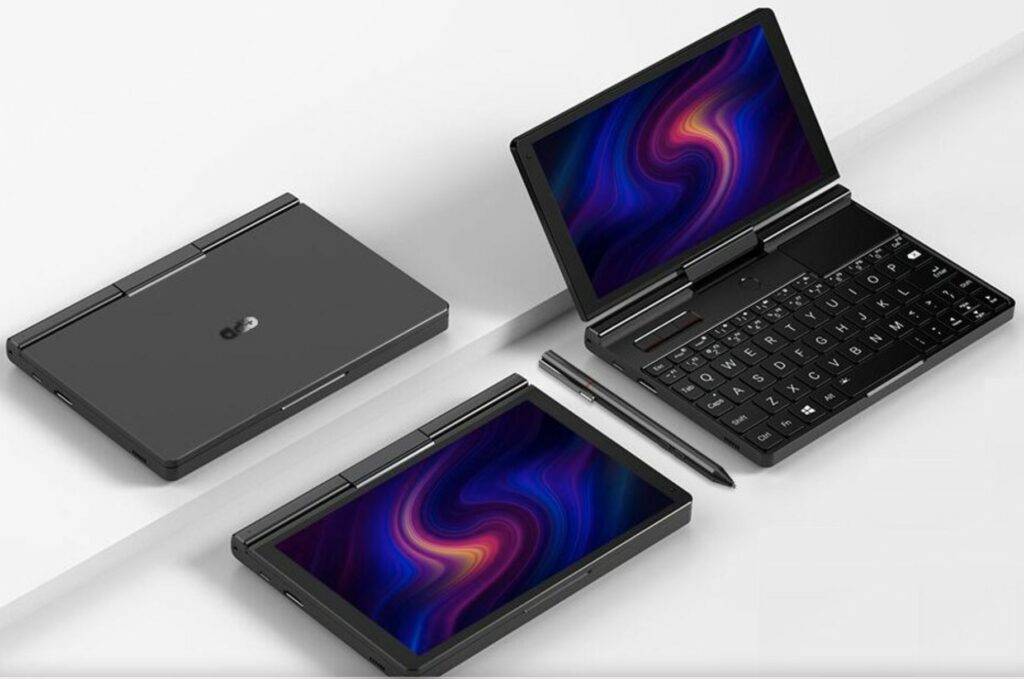
Modularity?
GPD have mentioned that some aspects of the device are modular, meaning that they should be easily user replaceable. It remains to be seen what exactly is modular about the device.
[20/10/2021] The GPD Pocket 3 features a modular interface on the rear of the unit, fastened in place with screws. This interface can be freely swap between multiple modules, allowing the GPD Pocket 3 to better adapt to it’s environment and use cases.
At the moment, only three modules have been observed:
- A standard USB module, featuring a single USB 3.2 Type-A port (Comes with the unit)
- A serial port module, featuring an RS-232 (Purchased Separately)
- A KVM module, featuring a HDMI-IN port and USB-IN port (Purchased Separately)

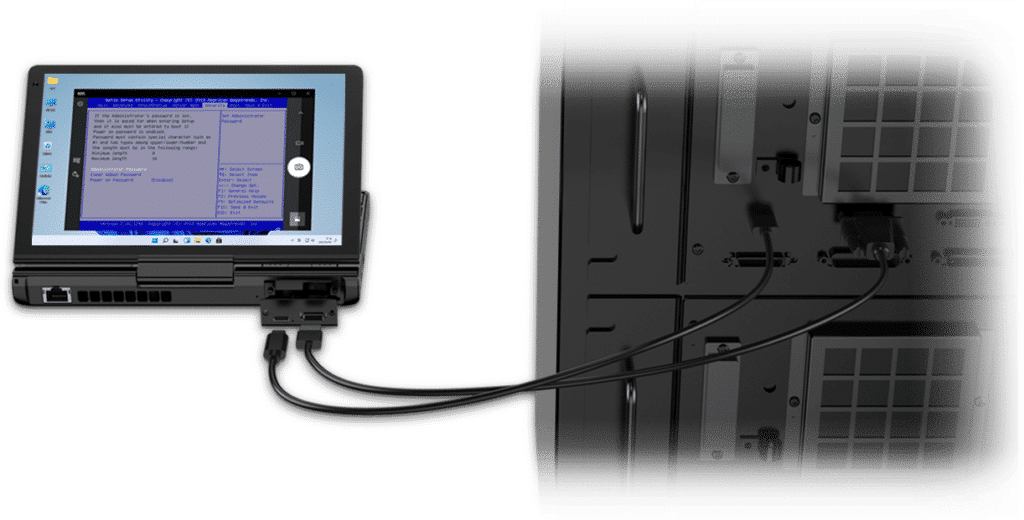
How big is the GPD Pocket 3?
GPD state that the Pocket 3 is “8 inches” in size. Whether or not they are referring to the screen, or the whole device (when closed) remains to be seen.
[20/10/2021] The GPD Pocket 3 has been stated to be approximately 198x137x20mm in size, making it not much larger than a mobile phone.
It is also approximately 725g in weight, making it suitably light for carrying around.
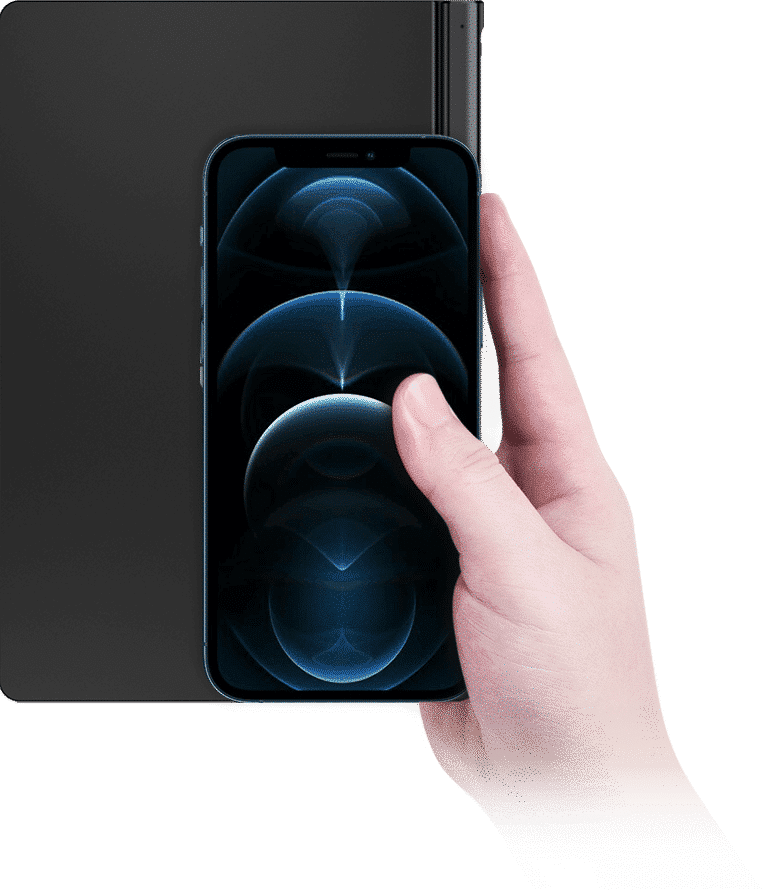
Display Rotation
The display on the Pocket 3 can be rotated 180 degrees on both the Y axis and the X axis.
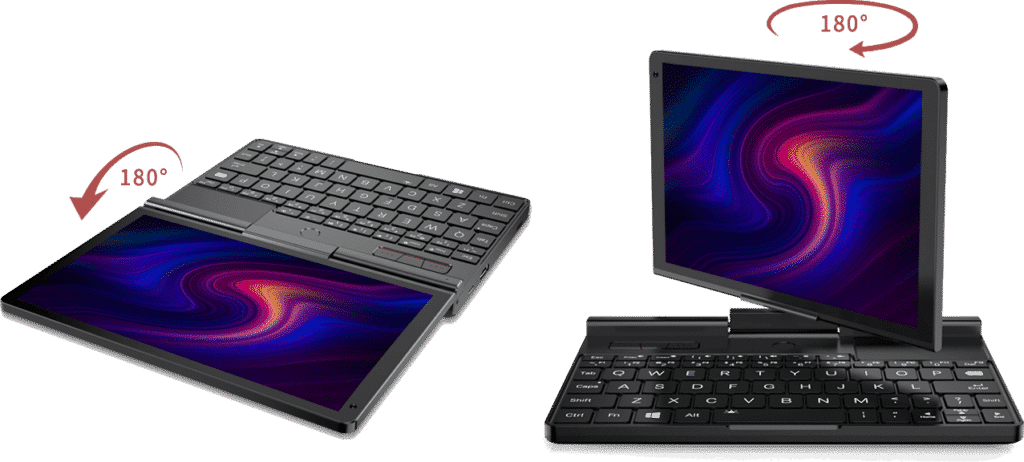
With the screen rotated fully on both axes, the device takes the form of a (very chunky) tablet. Identical to the One Netbook A1.
Stylus Support
The chunky tablet form achieved by this is useful, as the device has support for digital styluses. Featuring up to 4096 levels of pressure sensitivity.
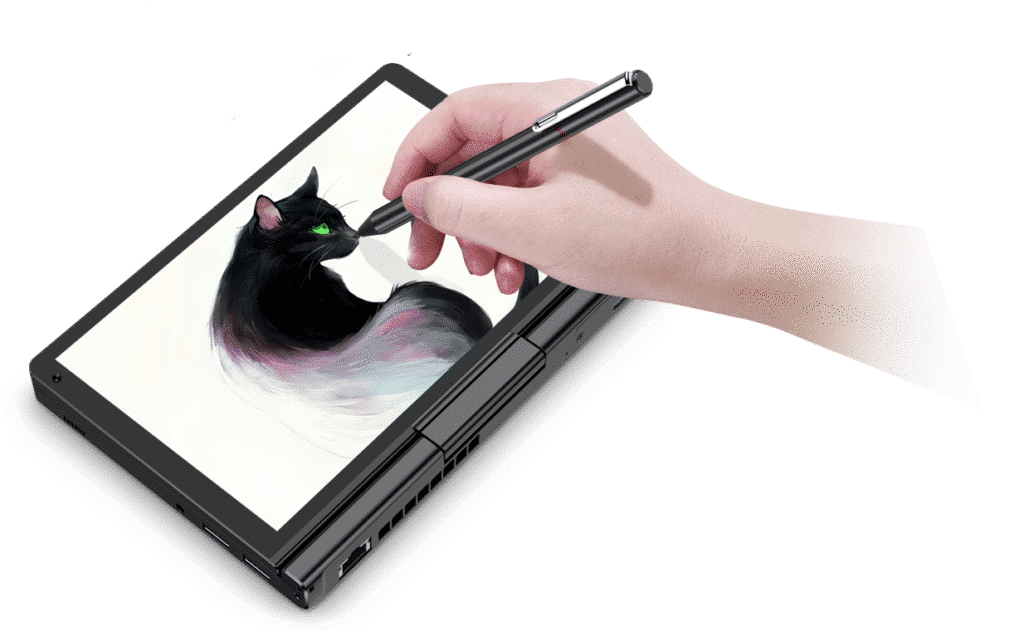
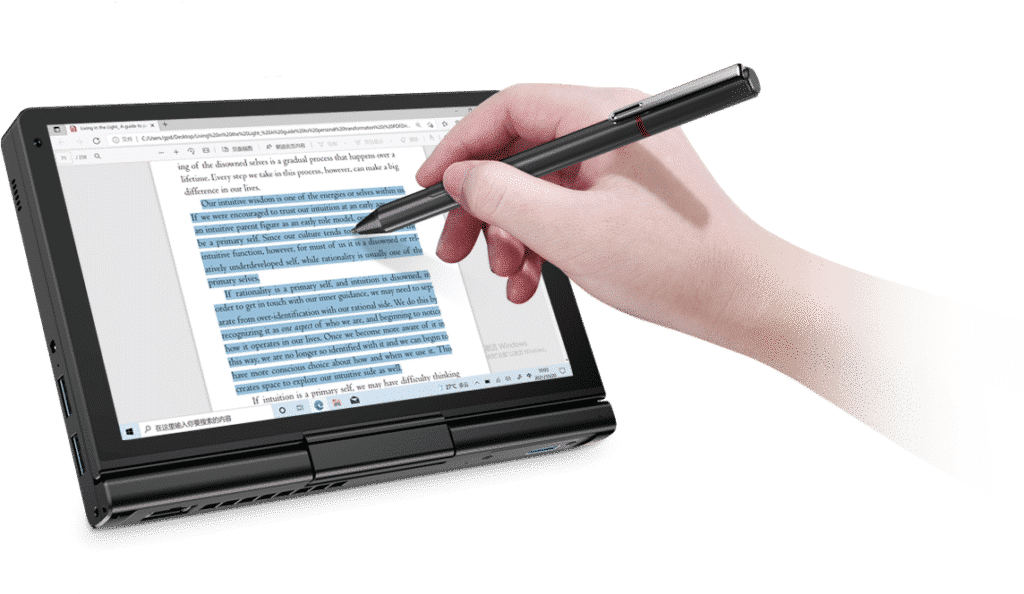
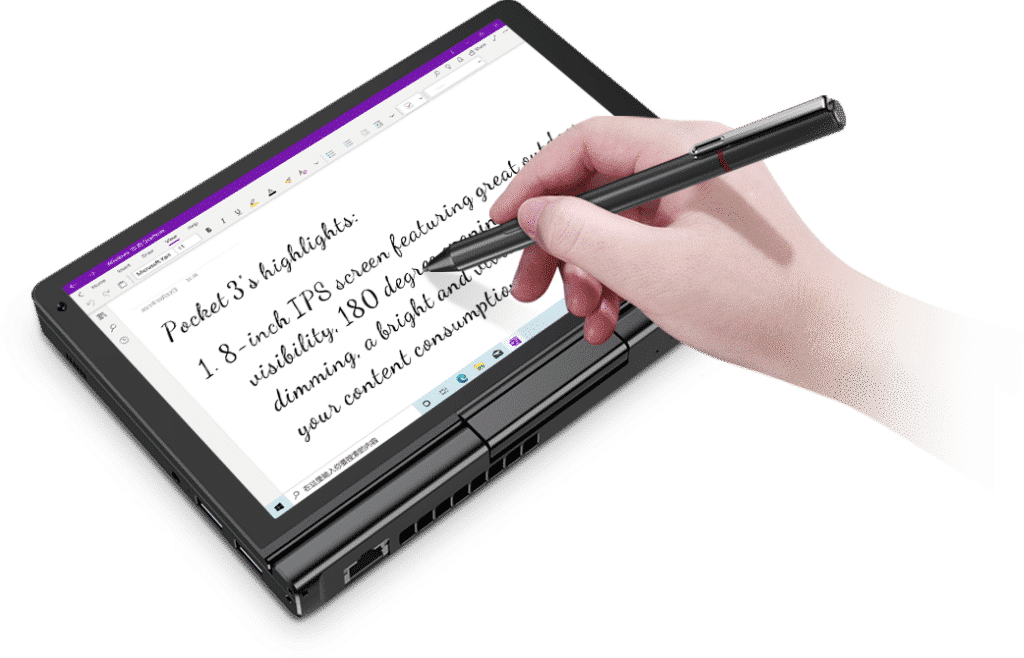
When is the GPD Pocket 3’s Release Date?
At this point in time we don’t have any information on the GPD Pocket 3’s release date, it’s pricing, or when/if the crowdfunding campaign will launch for it. We will update here with more info as it is revealed.
GPD Pocket 3 Price?
While no official price has been announced for the GPD Pocket 3, you can likely expect the price for the i7 version to be somewhere in the £800-1000 range – based on the current price of the GPD WIN 3.
The price for the Pentium N6000 model is entirely up in the air however, but it will without a doubt be the cheaper of the two. Likely in the £300-£600 range.
[12/11/2021 Update] The GPD Pocket 3’s crowdfunding page has launched, and with it, prices for the GPD Pocket 3 have been revealed.
The GPD Pocket 3 (base/Pentium model) is available from the crowdfunding page for approximately £484 GBP.
Meanwhile, the GPD Pocket 3 Pro (high-end/i7 model) is available for £744.
Both models come bundled with a stylus for use with the unit.
The base model falls in line with our expectations, but pleasantly, the higher-end model is slightly cheaper than expected.
Buyers can also opt to add an extra £60 to receive the KVM and RS-232 modules alongside the device.

